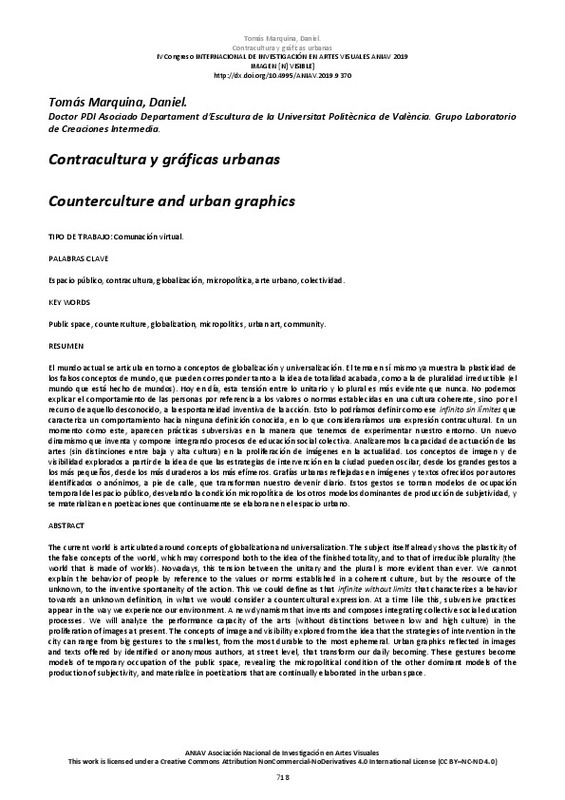JavaScript is disabled for your browser. Some features of this site may not work without it.
Buscar en RiuNet
Listar
Mi cuenta
Estadísticas
Ayuda RiuNet
Admin. UPV
Contracultura y gráficas urbanas
Mostrar el registro sencillo del ítem
Ficheros en el ítem
| dc.contributor.author | Tomás Marquina, Daniel
|
es_ES |
| dc.date.accessioned | 2019-10-25T06:32:05Z | |
| dc.date.available | 2019-10-25T06:32:05Z | |
| dc.date.issued | 2019-09-10 | |
| dc.identifier.isbn | 9788490487662 | |
| dc.identifier.uri | http://hdl.handle.net/10251/129460 | |
| dc.description.abstract | [ES] El mundo actual se articula en torno a conceptos de globalización y universalización. El tema en sí mismo ya muestra la plasticidad de los falsos conceptos de mundo, que pueden corresponder tanto a la idea de totalidad acabada, como a la de pluralidad irreductible (el mundo que está hecho de mundos). Hoy en día, esta tensión entre lo unitario y lo plural es más evidente que nunca. No podemos explicar el comportamiento de las personas por referencia a los valores o normas establecidas en una cultura coherente, sino por el recurso de aquello desconocido, a la espontaneidad inventiva de la acción. Esto lo podríamos definir como ese infinito sin límites que caracteriza un comportamiento hacia ninguna definición conocida, en lo que consideraríamos una expresión contracultural. En un momento como este, aparecen prácticas subversivas en la manera que tenemos de experimentar nuestro entorno. Un nuevo dinamismo que inventa y compone integrando procesos de educación social colectiva. Analizaremos la capacidad de actuación de las artes (sin distinciones entre baja y alta cultura) en la proliferación de imágenes en la actualidad. Los conceptos de imagen y de visibilidad explorados a partir de la idea de que las estrategias de intervención en la ciudad pueden oscilar, desde los grandes gestos a los más pequeños, desde los más duraderos a los más efímeros. Grafías urbanas reflejadas en imágenes y textos ofrecidos por autores identificados o anónimos, a pie de calle, que transforman nuestro devenir diario. Estos gestos se tornan modelos de ocupación temporal del espacio público, desvelando la condición micropolítica de los otros modelos dominantes de producción de subjetividad, y se materializan en poetizaciones que continuamente se elaboran en el espacio urbano. | es_ES |
| dc.description.abstract | [EN] The current world is articulated around concepts of globalization and universalization. The subject itself already shows the plasticity of the false concepts of the world, which may correspond both to the idea of the finished totality, and to that of irreducible plurality (the world that is made of worlds). Nowadays, this tension between the unitary and the plural is more evident than ever. We cannot explain the behavior of people by reference to the values or norms established in a coherent culture, but by the resource of the unknown, to the inventive spontaneity of the action. This we could define as that infinite without limits that characterizes a behavior towards an unknown definition, in what we would consider a countercultural expression. At a time like this, subversive practices appear in the way we experience our environment. A new dynamism that invents and composes integrating collective social education processes. We will analyze the performance capacity of the arts (without distinctions between low and high culture) in the proliferation of images at present. The concepts of image and visibility explored from the idea that the strategies of intervention in the city can range from big gestures to the smallest, from the most durable to the most ephemeral. Urban graphics reflected in images and texts offered by identified or anonymous authors, at street level, that transform our daily becoming. These gestures become models of temporary occupation of the public space, revealing the micropolitical condition of the other dominant models of the production of subjectivity, and materialize in poetizations that are continually elaborated in the urban space. | es_ES |
| dc.format.extent | 7 | es_ES |
| dc.language | Español | es_ES |
| dc.publisher | Editorial Universitat Politècnica de València | es_ES |
| dc.relation.ispartof | IV Congreso Internacional de investigación en artes visuales: ANIAV 2019 Imagen [N] visible | es_ES |
| dc.rights | Reconocimiento - No comercial - Sin obra derivada (by-nc-nd) | es_ES |
| dc.subject | Arte | es_ES |
| dc.subject | Producción artística | es_ES |
| dc.subject | Estética | es_ES |
| dc.subject | Teoría del arte | es_ES |
| dc.subject | Gestión cultural | es_ES |
| dc.subject | Educación artística | es_ES |
| dc.subject | Investigación artística | es_ES |
| dc.subject | Espacio público | es_ES |
| dc.subject | Contracultura | es_ES |
| dc.subject | Globalización | es_ES |
| dc.subject | Micropolítica | es_ES |
| dc.subject | Arte urbano | es_ES |
| dc.subject | Colectividad | es_ES |
| dc.title | Contracultura y gráficas urbanas | es_ES |
| dc.title.alternative | Counterculture and urban graphics | es_ES |
| dc.type | Capítulo de libro | es_ES |
| dc.type | Comunicación en congreso | es_ES |
| dc.identifier.doi | 10.4995/ANIAV.2019.2019.9370 | |
| dc.rights.accessRights | Abierto | es_ES |
| dc.contributor.affiliation | Universitat Politècnica de València. Departamento de Escultura - Departament d'Escultura | es_ES |
| dc.contributor.affiliation | Universitat Politècnica de València. Facultad de Bellas Artes - Facultat de Belles Arts | es_ES |
| dc.description.bibliographicCitation | Tomás Marquina, D. (2019). Contracultura y gráficas urbanas. En IV Congreso Internacional de investigación en artes visuales: ANIAV 2019 Imagen [N] visible. Editorial Universitat Politècnica de València. 718-724. https://doi.org/10.4995/ANIAV.2019.2019.9370 | es_ES |
| dc.description.accrualMethod | OCS | es_ES |
| dc.relation.conferencename | IV Congreso Internacional de Investigación en Artes Visuales. ANIAV 2019. Imagen [N] Visible | es_ES |
| dc.relation.conferencedate | Julio 03-05, 2019 | es_ES |
| dc.relation.conferenceplace | Valencia, Spain | es_ES |
| dc.relation.publisherversion | http://ocs.editorial.upv.es/index.php/ANIAV/ANIAV2019/paper/view/9370 | es_ES |
| dc.description.upvformatpinicio | 718 | es_ES |
| dc.description.upvformatpfin | 724 | es_ES |
| dc.type.version | info:eu-repo/semantics/publishedVersion | es_ES |
| dc.relation.pasarela | OCS\9370 | es_ES |








